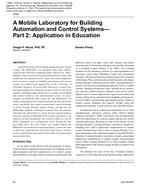Industrial halls are characterized with their rectangular shape and relatively simple construction, as contrasted with office buildings with similar floor area. Industrial halls are usually subject to high energy demand due to the many manufacturing processes, lighting, and the corresponding amount spent on space conditioning. Thermal comfort is seldom a concern for industrial halls. By contrast, saving in energy consumption for lighting and space conditioning is a big issue since even the modest percentage change in energy consumption could be translated into a large monetary sum.
With relatively loose requirement in space conditioning, and comparatively high internal heat gain; the approach in industrial hall design is quite different from that of office building. In fact, what poses to be an energy efficient design for office buildings might not be appropriate for high internal heat gain halls. The simplicity in the building geometry and the construction method allow the investigation of energy demand for space conditioning to be limited to a few number of demand side parameters (e.g. insulation value of walls); in which, change in values in some of the parameters presents a significant impact on the overall energy demand.
This paper investigates the impact of varying different demand side parameters on the energy demand for space conditioning and lighting for a typical industrial hall. Through building energy simulation, such impact can be investigated; and by applying optimization, the configurations of the most optimal combinations of parameters with the lowest energy demand can be identified. The result indicates that the energy demand of the least efficient configuration can be more than double of that of the optimized design solution. This paper will also explore green building assessment systems such as LEED, in terms of energy performance, with the studied industrial hall as an example. The huge energy saving brought by the optimized design solution over the baseline building of LEED suggests that there might be a potential deficiency of LEED rating system at its current state as it applies to industrial halls.
Citation: ASHRAE Conference Papers, Dallas, TX.
Product Details
- Published:
- 2013
- Number of Pages:
- 8
- File Size:
- 1 file , 1.5 MB
- Product Code(s):
- D-DA-13-C028


